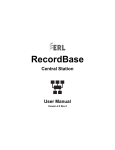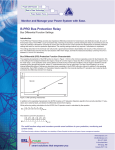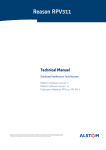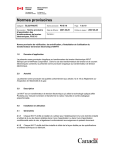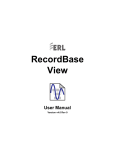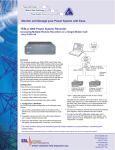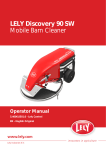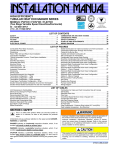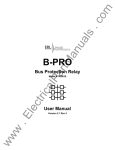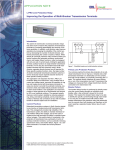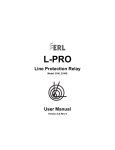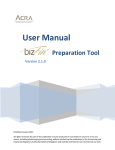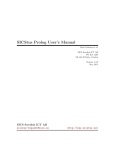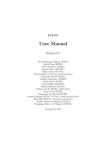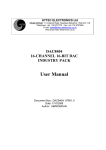Download RecordBase Central Station User Manual
Transcript
om .c ar tM an ua ls RecordBase ww w .E lec tri ca lP Central Station User Manual Version 1.4 Rev 1 w ww lP ca tri .E lec ar tM an ua ls .c om om .c Table of Contents Preface ......................................................................................i Contact Information ...................................................................i ar tM an ua ls Version Descriptions................................................................ iii Using This Guide ......................................................................v 1 System Overview ................................................... 1-1 RecordBase Features............................................................................ 1-1 System Description................................................................................ 1-2 What You Need To Set Up RecordBase ............................................... 1-3 RecordBase Modules ............................................................................ 1-4 RecordBase Versus TESLA Control Panel ........................................... 1-5 2 RecordBase Central Station and Tools Installation2-1 Planning Your Installation...................................................................... 2-1 RecordBase Central Station Setup Overview (for Windows 2000) ....... 2-3 Detailed Server Installation (for Windows 2000) ................................... 2-4 RecordBase Central Station Setup Overview (for Windows XP)......... 2-14 Detailed Server Installation (for Windows XP)..................................... 2-15 Commissioning and Verification of RecordBase ................................. 2-25 lP 3 RecordBase Central Station Details..................... 3-1 RecordBase Central Station Modules ................................................... 3-1 Starting, Monitoring and Stopping the Server Software ........................ 3-2 ca RecordBase Central Station Database.................................................. 3-3 4 Record Collection .................................................. 4-1 RecordBase Collector Module............................................................... 4-1 tri Adding a Recorder to the List ................................................................ 4-3 Polled Record Collection ....................................................................... 4-5 Manually-Initiated Record Collection ..................................................... 4-7 .E lec Recorder-Initiated Record Collection..................................................... 4-7 Central Cross-Triggering ....................................................................... 4-8 Manual Cross-Triggering ....................................................................... 4-9 5 Communication Monitoring .................................. 5-1 RecordBase Monitor Module ................................................................. 5-1 IED Status ............................................................................................. 5-2 Activity Log ............................................................................................ 5-3 ww w Diagnostic Log....................................................................................... 5-4 D02261R01.41 6 RecordBase Administrator.................................... 6-1 Record Classification System................................................................ 6-1 Deleting Records ................................................................................... 6-2 RecordBase Central Station User Manual i om Table of Contents Index ..........................................................................................I ww w .E lec tri ca lP ar tM an ua ls .c Software Installation Instructions .............................................III ii RecordBase Central Station User Manual D02261R01.41 om .c Preface ca lP ar tM an ua ls Information in this document is subject to change without notice. © 2007 ERLPhase Power Technologies Ltd. All rights reserved. Reproduction in any manner whatsoever without the written permission of ERLPhase Power Technologies Ltd. is strictly forbidden. This manual is part of a complete set of product documentation that includes detailed drawings and operation. Users should evaluate the information in the context of the complete set of product documentation and their particular applications. ERLPhase assumes no liability for any incidental, indirect, or consequential damages arising from the use of this documentation. While all information presented is believed to be reliable and in accordance with accepted engineering practices, ERLPhase makes no warranties as to the completeness of the information. All trademarks used in association with B-PRO, F-PRO, L-PRO, ProLogic, T-PRO, TESLA, TESLA Control Panel, RecordGraph and RecordBase are trademarks of ERLPhase Power Technologies Ltd. Windows® and Access® are registered trademarks of the Microsoft Corporation. tri Contact Information .E lec ERLPhase Power Technologies Ltd. Website: www.erlphase.com Email: [email protected] ww w Technical Support Email: [email protected] Tel: 204-477-0591 D02261R01.41 RecordBase Central Station User Manual i w ww lP ca tri .E lec ar tM an ua ls .c om om RecordBase Central Station Version Compatibility .c Version Descriptions ar tM an ua ls This chart indicates compatibility between versions of RecordBase Central Station and RecordBase View Release Date RecordBase Central Station Version Compatible RecordBase View Version 2007 Apr 13 v1.4 v1.5 2005 Aug 31 v1.3 v1.3 2003 Apr 17 v1.2 v1.5 2002 Oct 30 v1.1b v1.1 – v1.4 2002 May 06 v1.1a v1.1 – v1.3 2001 May 04 v1.1 v1.1 2001 Feb 13 v1.0 v1.0 lP RecordBase Central Station Version Summary RecordBase Central Station Version ca Release Date Change Summary (for details, see the Release Description) v1.4 Supports TESLA 3000 Cooperative Mode and improvements to running under Windows limited user accounts 2005 Aug 31 v1.3 Supports TESLA 3000 and 2000 2003 Apr 17 v1.2 Adds LAN support to TESLA communication. .E lec tri 2007 Apr 13 Supports systems with up to 100 TESLA recorders. 2002 Oct 30 v1.1b Supports the latest version of record produced by the TESLA recorder. 2002 May 06 v1.1a Increased maximum size of the IED phone number to 50 characters. Corrected handling of records with >100 events. v1.1 Uses RecordBase View as the Server’s record user interface. 2001 Feb 13 v1.0 First release. ww w 2001 May 04 D02261R01.41 RecordBase Central Station User Manual iii om Version Descriptions Manual Version Changes from Previous Version 2008 Feb 29 v1.4 Rev1 Branded to ERLPhase. 2007 Apr 13 2005 Aug 31 2003 Apr 17 2002 Oct 30 2002 May 2002 May 09 2001 May 04 v1.4 Update to RecordBase v1.4 v1.3 Update to RecordBase v1.3 v1.2 Update to RecordBase v1.2. v1.1 Rev 4 Update to include new features and new format. v1.1 Rev 3 Add to version description tables. v1.1 Rev 2 Incorporate Addendum 1 into manual. v1.1 Manual reflects software changes. v1.0 First release. ww w .E lec tri ca lP 2001 Feb 13 ar tM an ua ls Date .c RecordBase Central Station User Manual Revision History iv RecordBase Central Station User Manual D02261R01.41 om .c Using This Guide ar tM an ua ls This User Manual describes the installation and operation of RecordBase Central Station software. It is intended to support the first time user and clarify the details of the equipment. RecordBase View, the record database and graphics tool, is described in a separate user manual. The manual uses a number of conventions to denote special information: Example Describes Start>Settings>Control Panel Choose the Control Panel submenu in the Settings submenu on the Start menu. Right-click Click the right mouse button. Recordings APT_RB_1 Menu items and tabs are shown in italics. User input or keystrokes are shown in bold. Relate important notes and information. lP Text boxes similar to this one ca Different coloured icons denote the different program sections. RecordBase System Manager (blue) tri Blue RecordBase Collector (green) .E lec Green RecordBase Administrator (red) Red RecordBase Monitor (yellow) ww w Yellow D02261R01.41 RecordBase Central Station User Manual v w ww lP ca tri .E lec ar tM an ua ls .c om om .c 1 System Overview TESLA Recorder TESLA Disturbance Reorder Model 2000 Telephone Network ar tM an ua ls The RecordBase Central Station software provides automated collection, storage and network-wide access to fault and disturbance data produced by TESLA Model 2000 and 3000 recorders. RecordBase ensures your recorder data is automatically brought to a secure central location and is made available to staff throughout your company for display and analysis. IRIG-B Functional Records Stored Test Mode Alarm Modem TESLA Recorder TESLA Disturbance Reorder Model 2000 Recorder Functional IRIG-B Functional Records Stored Test Mode Alarm TESLA Recorder TESLA Disturbance Reorder Model 2000 TESLA Recorder TESLA Disturbance Reorder Model 2000 Corporate LAN Modem Recorder Functional RecordBase View RecordBase Server RecordBase View Recorder Functional IRIG-B Functional Records Stored Test Mode Alarm Recorder Functional IRIG-B Functional Records Stored Test Mode Alarm TESLA Recorder TESLA Disturbance Reorder Model 2000 Recorder Functional IRIG-B Functional Records Stored Test Mode Alarm lP Figure 1.1: System Overview RecordBase Features ww w .E lec tri ca • Provides automated record transfer from TESLA recorders on a call-out schedule or by a recorder initiation • Allows central cross-triggering of TESLA recorders for system-wide dynamic swing recording • Includes integrated record database with search, sort and filter functions • Access company-wide records on existing Windows Computers through the corporate LAN • Provides a graphical, interactive record display with timebase, phasor, harmonic and impedance analysis tools • Provides record summaries with classification and shared commentary work space • Provides graphical and numeric export to support generation and special analysis • Supports systems with up to 100 recorders • Supports both modem and LAN communication • Supports TESLA 3000 Cooperative Mode D02261R01.41 RecordBase Central Station User Manual 1-1 om 1 System Overview System Description ar tM an ua ls .c RecordBase consists of two main components: • RecordBase Central Station is a set of modules which handle record collection and storage • RecordBase View provides access to the data on existing desktop computers over the corporate LAN Central Station Software RecordBase View is a separate software client program (for details see RecordBase View User Manual). It is the primary tool for those who work with the data collected from the recorders. RecordBase View provides database search and sort functions, a summary display of each record, report tools and interactive display graphics. RecordBase View can run on existing desktop PCs running Windows 2000 or XP operating systems, and can access data on the RecordBase Central Station computer over the existing corporate LAN. You can also run RecordBase View on the same computer as RecordBase Central Station. .E lec tri RecordBase View ca lP The Central Station handles record acquisition and cross-triggering with TESLA recorders and maintains the central database of records. RecordBase Central Station communicates with TESLA recorders using modems and/or LAN. RecordBase Central Station runs on a PC with , Windows 2000 or Windows XP operating systems, and that PC should be dedicated to this purpose only. You can configure RecordBase Central Station to call TESLA recorders through a modem or LAN and automatically download new records. You can also set the call order and the call time. RecordBase Central Station accepts incoming calls from a recorder through a modem or LAN. You can set the recorder to notify RecordBase Central Station of a dynamic swing trigger or a new high priority record produced by the recorder. RecordBase Central Station maintains a database of information from the records it collects. The database, as well as the downloaded record files, may be located on the server’s hard disk or on another drive on the network. This allows you to place your data in a more secure location managed by your company’s information systems staff (if available). RecordBase Central Station is configured and managed using RecordBase Tools (Collector and Monitor) to control and to monitor its operation. These tools can be run on the server itself or remotely on another computer on the network. ww w RecordBase Database 1-2 The RecordBase database is based on Microsoft Access. Data is stored in a single central Access database file maintained by RecordBase Central Station and RecordBase Administrator. RecordBase View is implemented using a runtime version of Microsoft Access. It provides access to the RecordBase database. Multiple access to the central database file is controlled through record locking to ensure data integrity. Because RecordBase View uses a run-time version of Access, you do not need to have Access installed on either the Cen- RecordBase Central Station User Manual D02261R01.41 om 1 System Overview What You Need To Set Up RecordBase For RecordBase Central Station • A Pentium PC running Windows 2000 or Windows XP ar tM an ua ls RecordBase Central Station .c tral Station or any computer running RecordBase View. If you do have a copy of Access, you can use it to create your own reports and displays. For Modem Communication • One or two Windows-compatible modems (internal or external) with telephone lines - One modem for outgoing calls to recorders (required) - Second modem for incoming calls from recorders (only required if incoming calls via modem are to be supported) For LAN Communication tri ca lP • LAN card with the operating system and hardware in use • Storage space suitable for records and the database. (A typical TESLA record is from 100 KB–1 MB.) Alternatively, the database and records can be located on a network drive • Network connection that supports the TCP/IP protocol—required only if the database and records are stored on a network drive. LAN communication with TESLA is required. • Data backup facility recommended, if you are storing TESLA records on the server and there is no network-based backup facility To display records on the Server, the computer should also meet the requirements for RecordBase View: • Pentium class processor at 200 MHz or better is recommended • Display adapter that supports 800 x 600, small fonts mode is the minimum • 64 MB or greater is recommended • Printer (optional) RecordBase View and RecordBase Tools (optional) • • • • • • TESLA Recorders • TESLA 2000 Recorders with Firmware v2.1 or higher are required to work with RecordBase using modem communication • TESLA 2000 Recorders with Firmware v3.6 or higher are required to work with RecordBase using LAN communication • RecordBase supports all versions of TESLA 3000 ww w .E lec Pentium class processor at 200 MHz or better is recommended Windows 2000 or XP Network connection to the Server that supports the TCP/IP protocol Display adapter that supports 800 x 600, small fonts mode is the minimum 64 MB or greater is recommended Printer (optional), but a print driver is required to view the report summary D02261R01.41 RecordBase Central Station User Manual 1-3 om 1 System Overview RecordBase Modules .c RecordBase Central Station consists of a number of software modules that work together. In addition to the modules that provide the underlying communication and data acquisition functions, there are user interface modules used to manage the system. ar tM an ua ls Server PC Desktop PC RecordBase View RecordBase Collector Green RecordBase Administrator RecordBase Monitor Red Yellow Server Modules LAN RecordBase View Modem Records and Database Files Ethernet TCP/IP RecordBase Monitor Yellow RecordBase Collector Green Modem Figure 1.2: RecordBase Modules RecordBase Monitor displays the type and result of the last communication session with each TESLA recorder. It provides access to the system’s communication activity and diagnostic logs. The Monitor also has controls to initiate an immediate cross-trigger of all recorders or to initiate a record collection call-around. The Monitor is used by the system administrator or by general RecordBase users who need basic status information and the ability to initiate exceptional record acquisition action. It can be run on the Server or an another PC on the network. RecordBase Collector provides control over the system’s record collection function. It identifies the TESLA recorders and specifies the record collection and cross-trigger rules. RecordBase Collector is a system administrator’s tool and is typically run on the Server, although it can be run from any network computer. .E lec RecordBase Collector tri ca lP RecordBase Monitor RecordBase Administrator provides database management tools including record deletion, modification and import. The Administrator is a system administrator’s tool and must be run on the Server. Server Modules The Server Modules are a set of software components that control the automated record collection and communication functions. They run continuously on the Server machine and form the core of the RecordBase system. ww w RecordBase Administrator 1-4 RecordBase Central Station User Manual D02261R01.41 om 1 System Overview RecordBase Versus TESLA Control Panel .c TESLA Control Panel software is the basic user interface for the TESLA recorders to configure and control the recorder. RecordBase does not replace this function. ar tM an ua ls TESLA Control Panel version 2.1 or greater is required to configure a TESLA to work with RecordBase via modem. This version contains settings to control TESLA calls to RecordBase to report swing triggers or to initiate record transfer. TESLA Control Panel version 3.6 or greater is required to configure TESLA to work with RecordBase via LAN. As an alternative to the above, TESLA 3000 Control Panel v1.0 or above can be used. Control Panel may be run on the RecordBase Central Station computer and make use of the Server’s outgoing modem or LAN card to communicate with recorders. If using a modem, the Server must have an APT_MODEM dial-up network configuration for TESLA Control Panel to use (refer to TESLA User Manual for further details). Set it up to use the same modem as RecordBase uses for dial-out. When Control Panel is using the modem, RecordBase is unable to use it. RecordBase treats this as a failed call attempt and follows its configured call retry rules. If the maximum number of retries is reached, RecordBase abandons the call attempt. If RecordBase is using the call-out modem when you try to connect to a recorder using Control Panel, Control Panel reports a communication error. You can try again when RecordBase has finished with the modem. tri ca lP Running Control Panel on the RecordBase Central Station ww w .E lec If your system is set up to receive modem calls from recorders, extended use of the outgoing Server modem by Control Panel could result in missed cross-triggers or record transfers. If your system is set up to receive LAN calls from recorders, this is not an issue. D02261R01.41 RecordBase Central Station User Manual 1-5 om 1 System Overview It is possible to manually add a record that has been transferred from a recorder using Control Panel to RecordBase. In Control Panel, select the desired record from the Records List and use the Save As button to place the file on a diskette or a shared directory. Use RecordBase Administrator to add the record to the database. You can also use RecordBase View to add records to the RecordBase Central Station database. To add a record run RecordBase View and select File>Open. From the drop-down menu select the RecordBase database (C:\Program Files\NxtPhase\RecordBase\Database\RecordBase.mdb) and OK. Select Add and choose the record to be added. The Records Found number should be updated showing that you have added a new record. For more information refer to the RecordBase View User Manual. ww w .E lec tri ca lP ar tM an ua ls .c Adding Records from Control Panel 1-6 RecordBase Central Station User Manual D02261R01.41 om .c 2 RecordBase Central Station and Tools Installation ar tM an ua ls The section “Planning Your Installation” is common to both Windows 2000 and Windows XP. For Windows 2000 server setup details and installation instructions refer to “RecordBase Central Station Setup Overview (for Windows 2000)” on page 23 and “Detailed Server Installation (for Windows 2000)” on page 2-4. For Windows XP server setup details and installation instructions refer to “RecordBase Central Station Setup Overview (for Windows XP)” on page 2-14 and “Detailed Server Installation (for Windows XP)” on page 2-15. Planning Your Installation This section describes RecordBase installation and the available choices. For system requirements see “What You Need To Set Up RecordBase” on page 13. During Server software installation there are two options—Full Server Installation and RecordBase Tools Only. Full Server installation installs the core server/database files and RecordBase Tools. You should install only one instance of Full Server on your entire network. This computer must have TCP/IP capability. RecordBase Tools RecordBase Tools consists of two modules—RecordBase Collector and RecordBase Monitor. These modules may be installed on the server or any network computer to allow the administration of RecordBase Central Station remotely. The network computer must have a TCP/IP link with the Server. You may run approximately 15 simultaneous instances of Collector and Monitor. The table below summarizes the functionality of RecordBase Tools, for details see “Record Collection” on page 4-1 and “Communication Monitoring” on page 5-1. .E lec tri ca lP Full Server Functionality RecordBase Monitor Monitors communication with recorders. Manually initiates system-wide swing trigger. Initiates manual collection of records from a recorder. RecordBase Collector Defines recorders and communication parameters. Sets record collection times and rules. Provides a way to shut down RecordBase. Sets the number of logfile entries. ww w Module D02261R01.41 RecordBase Central Station User Manual 2-1 om 2 RecordBase Central Station and Tools Installation To use RecordBase’s automatic record collection capability, we recommend that you either dedicate a computer to run RecordBase Central Station or ensure that other programs that run on the shared computer are known and predictable. .c Selection of a Server Computer Modems and Telephone Lines ar tM an ua ls We do not recommend installing RecordBase Central Station on a computer that runs numerous different software packages or one that is used for general day-to-day tasks. The Server can be set up to use one or two modems to communicate with the recorders. The first modem (outgoing) is used exclusively for outgoing calls to the recorders to collect records or initiate a swing recording. The second modem (incoming) is optional and is used for incoming calls from the recorders to report new records or initiate swing cross-triggering. The need for the incoming modem depends on which communication features you plan to use. Modem Required Communication Feature Outgoing Schedule polling calls to recorders to collect records. Manually initiate calls to recorders to collect records. Manually initiate swing triggering to all recorders. Incoming lP A connection to your LAN is required if you plan to do any of the following: • Store your database on a computer other than RecordBase Central Station • Analyze records from a computer other than RecordBase Central Station • Configure and monitor the record collection process from a computer other than RecordBase Central Station • Use RecordBase Central Station to fetch records or to initiate swing triggering over the LAN • Allow new record notification or cross trigger notification for recorders over the LAN You do not need a network connection if you plan to store the data on the server machine and you work with record data only on that machine. .E lec tri ca Network Connection Allows new record notification from recorders. Allows cross-trigger notification from recorders. ww w TCP/IP 2-2 RecordBase Central Station requires TCP/IP in order to communicate with recorders, for details see “Remote Access Service (RAS) Setup” on page 2-5 for Windows 2000 and “Remote Access Service (RAS) Setup” on page 2-16 for Windows XP. RecordBase Tools require TCP/IP to communicate with RecordBase Central Station. RecordBase View does not require TCP/IP to access RecordBase Database; but the client machine (the PC that runs RecordBase View) must be in the same network domain as RecordBase Central Station. RecordBase Central Station User Manual D02261R01.41 om 2 RecordBase Central Station and Tools Installation Full Server installation creates a default folder for RecordBase Database in “C:\Program Files\NxtPhase\RecordBase Server\Database.” The database folder contains the file rb.mdb and all record files. Record files can range from about 100 KB to 1 MB each, so make sure your hard disk has sufficient storage space. We recommend that you do a regular backup of the database folder. .c Data Storage ar tM an ua ls RecordBase Central Station Setup Overview (for Windows 2000) This section provides an overview of the steps involved in setting up RecordBase Central Station. Detailed instructions appear in following sections. Decide first whether you wish RecordBase to use one modem (for calling TESLA recorders), two modems (one for calling TESLA recorders and another for accepting calls from TESLA recorders) or LAN. RecordBase can also use a combination of modems and LAN. In this case RecordBase calls TESLA recorders for record collection. 1 Install Server software from the CD-ROM. 2 Define IEDs, for details see “Adding a Recorder to the List” on page 4-3. 3 If desired, allow remote computers to access the RecordBase Database by creating a share on the database folder (C:\ProgramFiles\NxtPhase\RecordBase\database). 4 5 Ensure Windows 2000 Service Pack 2 or later is applied. RecordBase with Two Modems Overview In this case RecordBase is not only able to call TESLA recorders, but is also able to receive calls from them. In addition to the above steps, perform the following: 1 Create a new user account on the server machine for the TESLA recorders, for details see “New User Account Setup” on page 2-4. 2 In Control Panel, Administrative Tools, Services ensure that the Routing and Remote Access service is set to run automatically and modems are configured and functional, for details see “Remote Access Service (RAS) Setup” on page 2-5. .E lec tri ca lP RecordBase with One Modem Overview In addition to (or instead of) modems, RecordBase has the ability to call TESLA Recorders and receive calls from them over the LAN. 1 Follow the steps according to “RecordBase with One Modem Overview” on page 2-3, starting with step 1. ww w RecordBase with LAN Overview D02261R01.41 RecordBase Central Station User Manual 2-3 om 2 RecordBase Central Station and Tools Installation Detailed Server Installation (for Windows 2000) .c New User Account setup is only necessary for installations with two modems (IEDs are allowed to call in and out). 1 In Control Panel Administrative Tools/Computer Management, open the Local Users and Groups branch and right-click Users. 2 Choose New User... from the pop-up menu. ar tM an ua ls New User Account Setup Figure 2.3: New User .E lec tri ca lP 3 Create a new user account with the name tesla2000, type password as T3S5A3720 and confirm. 4 Uncheck User must change password at next logon. 5 Check User cannot change password. 6 Check Password never expires. ww w Figure 2.4: New Account Information 2-4 7 Click the Create button and close the New User dialog box. RecordBase Central Station User Manual D02261R01.41 om 2 RecordBase Central Station and Tools Installation Remote Access Service (RAS) Setup is only necessary for installations with two modems (IEDs are allowed to call in and out). Skip this section if you don’t need modem access to/from recorders. 1 Go to Control Panel/Administrative Tools/Services. 2 Check the status of Routing and Remote Access service. The start-up type should be set to Automatic and its status should be Started. ar tM an ua ls .c Remote Access Service (RAS) Setup Figure 2.5: RAS Setup .E lec tri ca lP 3 If it is not, double-click it to bring up Properties, set the Start-up Type to Automatic and start the service. ww w Figure 2.6: RAS Properties D02261R01.41 4 Go to Control Panel/Network and Dial-up Connections. 5 Double-click Incoming Connections. RecordBase Central Station User Manual 2-5 om ar tM an ua ls .c 2 RecordBase Central Station and Tools Installation Figure 2.7: Network and Dial-up Connection .E lec tri ca lP 6 Choose the dial-in modem to allow incoming calls. Figure 2.8: Incoming Connections Properties ww w 7 Go to the Users tab and allow the “tesla2000” user to connect 2-6 RecordBase Central Station User Manual D02261R01.41 om .c 2 RecordBase Central Station and Tools Installation ar tM an ua ls tesla[tesla2000] lP Figure 2.9: TESLA User Connection ww w .E lec tri ca 8 Go to the Networking tab, ensure Internet Protocol (TCP/IP) is checked, select it and click Properties. D02261R01.41 RecordBase Central Station User Manual 2-7 om ar tM an ua ls .c 2 RecordBase Central Station and Tools Installation lP Figure 2.10: Networking Properties ww w .E lec tri ca 9 Uncheck the Allow callers to access my local area network. 10 Check the Specify TCP/IP addresses and enter a From address of 192.168.102.160 and a To address of 192.168.102.180. 11 Uncheck the Allow calling computer to specify its own IP address. 2-8 Figure 2.11: TCP/IP Address RecordBase Central Station User Manual D02261R01.41 om 2 RecordBase Central Station and Tools Installation .c 12 Click OK to close the Incoming TCP/IP Properties dialog box. 13 Click OK to close the Incoming Connections Properties dialog box. Skip this section if you don’t need modem access to recorders. ar tM an ua ls 1 First manually copy the file “c:/program files/accessories/RBtesla.scp” to the “c:/winnt/system32/ras/” directory. 2 Go to Control Panel, Network and Dial-up Connections. 3 Double-click Make New Connection to open the Network Connection Wizard. lP Phone Book Entry Setup ca Figure 2.12: Create a Connection ww w .E lec tri 4 Choose Network Connect Type as Dial-up to private network and click Next. D02261R01.41 Figure 2.13: Network Connection RecordBase Central Station User Manual 2-9 ar tM an ua ls .c 5 Select the modem to be used for dial-out. Click Next. om 2 RecordBase Central Station and Tools Installation Figure 2.14: Choose Modem .E lec tri ca lP 6 Leave the Phone Number to Dial as blank. Click Next. ww w Figure 2.15: Dialin Telephone Number 2-10 RecordBase Central Station User Manual D02261R01.41 om 2 RecordBase Central Station and Tools Installation ar tM an ua ls .c 7 Choose Connection Availability as For all users. Click Next. Figure 2.16: Connection Availability .E lec tri ca lP 8 Call this connection exactly as APT_RB_1 (must be exactly as shown). Click Finish. ww w Figure 2.17: Connection Name D02261R01.41 RecordBase Central Station User Manual 2-11 om 2 RecordBase Central Station and Tools Installation ar tM an ua ls .c 9 Click Properties in the Connect APT_RB_1 dialog box that opens. ww w .E lec tri ca lP Figure 2.18: Connect APT_RB_1 2-12 Figure 2.19: Choose Modem RecordBase Central Station User Manual D02261R01.41 om 2 RecordBase Central Station and Tools Installation ar tM an ua ls .c 10 Select the Security tab and set it to run the script “RBtesla.scp”. Click OK. lP Figure 2.20: Security Properties ww w .E lec tri ca 11 Cancel the Connect APT_RB_1 dialog box that appears. D02261R01.41 RecordBase Central Station User Manual 2-13 om 2 RecordBase Central Station and Tools Installation .c RecordBase Central Station Setup Overview (for Windows XP) ar tM an ua ls This section provides an overview of the steps involved in setting up RecordBase Central Station. Detailed instructions appear in following sections. Decide first whether you wish RecordBase to use one modem (for calling TESLA recorders) or two modems (one for calling TESLA recorders and another for accepting calls from TESLA recorders). The latter case involves more installation steps. In this case RecordBase calls TESLA recorders for record collection. 1 Install Server software from the CD-ROM. 2 Define IEDs, for details see “Adding a Recorder to the List” on page 4-3. 3 If desired, allow remote computers to access the RecordBase Database by creating a share on the database folder (C:\ProgramFiles\NxtPhase\RecordBase\database). 4 Ensure Windows XP Service Pack 1 or later is applied. RecordBase with Two Modems Overview In this case RecordBase is not only able to call TESLA recorders, but also able to receive calls from them. In addition to the above steps, perform the following: 1 Create a new user account on the server machine for the TESLA recorders, for details see for details see Figure 2.22: New Account Information on page 2-15. 2 In Control Panel, Administrative Tools, Services ensure that the Routing and Remote Access service is set to run automatically and modems are configured and functional, for details see “Remote Access Service (RAS) Setup” on page 2-16. 3 Continue as in the section “RecordBase with One Modem Overview” starting with Step 2. tri In addition to (or instead of) modems, RecordBase has the ability to call TESLA Recorders and receive calls from them over the LAN. 1 Follow the steps according to “RecordBase with One Modem Overview” on page 2-14 starting with step 1. ww w .E lec RecordBase with LAN Overview ca lP RecordBase with One Modem Overview 2-14 RecordBase Central Station User Manual D02261R01.41 om 2 RecordBase Central Station and Tools Installation Detailed Server Installation (for Windows XP) .c New User Account setup is only necessary for installations with two modems (IEDs are allowed to call in and out). 1 In Control Panel Administrative Tools/Computer Management, open the Local Users and Groups branch and right-click Users. 2 Choose New User... from the pop-up menu. ar tM an ua ls New User Account Setup Figure 2.21: New User .E lec tri ca lP 3 Create a new user account with the name tesla2000, type password as T3S5A3720 and confirm. 4 Uncheck User must change password at next logon. 5 Check User cannot change password. 6 Check Password never expires. ww w Figure 2.22: New Account Information D02261R01.41 7 Click the Create button and close the New User dialog box. RecordBase Central Station User Manual 2-15 om 2 RecordBase Central Station and Tools Installation Remote Access Service (RAS) Setup is only necessary for installations with two modems (IEDs are allowed to call in and out). Skip this section if you don’t need modem access to/from recorders. 1 Go to Control Panel/Administrative Tools/Services. 2 Check the status of Routing and Remote Access service. The start-up type should be set to Automatic and its status should be Started. ar tM an ua ls .c Remote Access Service (RAS) Setup Figure 2.23: RAS Setup .E lec tri ca lP 3 If it is not, double-click it to bring up Properties, set the Start-up Type to Automatic and start the service. ww w Figure 2.24: RAS Properties 2-16 RecordBase Central Station User Manual D02261R01.41 om 2 RecordBase Central Station and Tools Installation ar tM an ua ls .c 4 Go to Control Panel/Network Connections. 5 Double-click Incoming Connections. Figure 2.25: Network Connections .E lec tri ca lP 6 Choose the dial-in modem to allow incoming calls. ww w Figure 2.26: Incoming Connections Properties D02261R01.41 RecordBase Central Station User Manual 2-17 ar tM an ua ls .c 7 Go to the Users tab and allow the “tesla2000” user to connect om 2 RecordBase Central Station and Tools Installation Figure 2.27: TESLA User Connection .E lec tri ca lP 8 Go to the Networking tab, ensure Internet Protocol (TCP/IP) is checked, select it and click Properties. ww w Figure 2.28: Networking Properties 2-18 9 Uncheck the Allow callers to access my local area network. RecordBase Central Station User Manual D02261R01.41 om 2 RecordBase Central Station and Tools Installation ar tM an ua ls .c 10 Check the Specify TCP/IP addresses and enter a From address of 192.168.102.160 and a To address of 192.168.102.180. 11 Uncheck the Allow calling computer to specify its own IP address. Figure 2.29: TCP/IP Address 12 Click OK to close the Incoming TCP/IP Properties dialog box. 13 Click OK to close the Incoming Connections Properties dialog box. Skip this section if you don’t need modem access to recorders. lP 1 First manually copy the file “c:/program files/accessories/RBtesla.scp” to the “c:/winnt/system32/ras/” directory. 2 Go to Control Panel, Network Connections. 3 Double-click New Connection Wizard to open the New Connection Wizard. ww w .E lec tri ca Phone Book Entry Setup D02261R01.41 Figure 2.30: Create a Connection RecordBase Central Station User Manual 2-19 om 2 RecordBase Central Station and Tools Installation ar tM an ua ls .c 4 Choose Network Connect Type as Connect to the network at my workplace and click Next. Figure 2.31: Network Connection Type .E lec tri ca lP 5 Choose Dial-up Connection and click Next. Figure 2.32: Network Connection ww w 6 Type in the name APT_RB_1 exactly as shown. Click Next. 2-20 RecordBase Central Station User Manual D02261R01.41 om ar tM an ua ls .c 2 RecordBase Central Station and Tools Installation ww w .E lec tri ca lP Figure 2.33: Connection Name D02261R01.41 RecordBase Central Station User Manual 2-21 ar tM an ua ls .c 7 Leave the Phone Number to Dial as blank. Click Next. om 2 RecordBase Central Station and Tools Installation Figure 2.34: Dialin Telephone Number to Dial .E lec tri ca lP 8 Click Finish. ww w Figure 2.35: Completing the New Connection Wizard 2-22 RecordBase Central Station User Manual D02261R01.41 om 2 RecordBase Central Station and Tools Installation ar tM an ua ls .c 9 Click Properties in the Connect APT_RB_1 dialog box that opens. .E lec tri ca lP Figure 2.36: Connect APT_RB_1 ww w Figure 2.37: Choose Modem D02261R01.41 RecordBase Central Station User Manual 2-23 om 2 RecordBase Central Station and Tools Installation ar tM an ua ls .c 10 Select the Options tab and ensure the Settings match for details see Figure 2.38: Options Properties on page 2-24. Figure 2.38: Options Properties .E lec tri ca lP 11 Select the Security tab and set it to run the script “RBtesla.scp”. Click OK. ww w Figure 2.39: Security Properties 2-24 12 Cancel the Connect APT_RB_1 dialog box that appears. RecordBase Central Station User Manual D02261R01.41 om 2 RecordBase Central Station and Tools Installation Commissioning and Verification of RecordBase Testing the Dial-Out and/or Outgoing LAN Connection ar tM an ua ls .c Communication must be tested to verify that RecordBase is configured properly. Before RecordBase can communicate with a remote TESLA recording system, the recorders must have Firmware version 2.1 or greater (for modem communication) or version 3.6 or greater (for LAN communication) and RecordBase Central Station must be running during the verification process. To run RecordBase Central Station, select Start>Program Files>NxtPhase>RecordBase> RecordBase System Manager. Since the Server modules run invisibly in the background, the blue RecordBase icon at the bottom right corner indicates a running RecordBase Central Station. This procedure verifies that RecordBase is able to dial out and communicate with remote TESLA recorders. It applies whether your RecordBase system communicates with TESLA recorders using modems or LAN. Requirements • TESLA recorder • RecordBase Collector • RecordBase Monitor Procedure Overview lP • Define a TESLA recorder to RecordBase. • Initiate a call from RecordBase to the TESLA recorder. If the call succeeds, RecordBase automatically fetches its UnitID and Serial Number. Procedure Details ww w .E lec tri ca 1 Run RecordBase Collector and create a New IED by selecting the New button and input its Location and Phone Number or IP address. Select OK to exit the New dialog box. D02261R01.41 Figure 2.40: Set Up New IED RecordBase Central Station User Manual 2-25 om 2 RecordBase Central Station and Tools Installation ar tM an ua ls .c 2 Select the newly created IED from the list and the Edit button. Ensure the phone number or IP address is correct and select the Get Information From IED button. RecordBase should start calling the IED within ten seconds. Figure 2.41: Edit IED ca This procedure verifies that TESLA recorders can successfully dial into RecordBase and communicate with it. This step is only applicable if RecordBase has been set up with two modems or if it communicates with TESLA recorders over LAN. If your RecordBase system only has one modem, skip this section. tri Testing the Dial-In and/or Incoming LAN Connection lP 3 During the call, use RecordBase Monitor to view the status. When the call ends, if all goes well, the Call Status column should say successful and the unit’s UnitID field should have been automatically filled in. There will also be an entry for this operation in Monitor’s Activity Log view. Requirements .E lec • TESLA recorder • TESLA Control Panel • RecordBase Monitor Procedure Overview • Configure the TESLA recorder to notify RecordBase of new records. • Trigger the recorder and allow it to call RecordBase. • Use RecordBase Monitor to view the call status and activity. ww w Procedure Details 2-26 1 Verify the Dial-Out Connection by checking the preceding instructions. RecordBase only accepts calls from IEDs that are known to it (known IEDs appear in RecordBase Monitor’s IED list), so you must first establish a working connection with an IED. RecordBase Central Station User Manual D02261R01.41 om 2 RecordBase Central Station and Tools Installation Testing Database Operation ar tM an ua ls .c 2 Configure the TESLA recorder (using TESLA Control Panel) to notify RecordBase when it has new records. 3 Trigger the TESLA to generate a record (using Control Panel). This should force it to call RecordBase. 4 Monitor the activity using RecordBase Monitor (on the main IED Status screen). After the call is complete, the Call Type for that IED should be incoming, and the Call Status should be new records. An entry also appears in the RecordBase Monitor’s Activity Log view. This procedure helps to verify that TESLA recorders can successfully contact RecordBase and communicate with it. This step is only applicable if RecordBase has been set up with two modems. If your RecordBase system only has one modem, skip this section. Requirements • • • • TESLA recorder TESLA Control Panel RecordBase Monitor RecordBase Administrator (part of RecordBase Central Station installation) Procedure Overview • This procedure extends the Dial-Out test to actually fetch records and ensure they are entered into the RecordBase Database. lP Procedure Details ww w .E lec tri ca 1 Verify the Dial-Out Connection by using the preceding instructions. 2 Configure the TESLA recorder (using TESLA Control Panel) not to notify RecordBase. 3 Create one or more records on the TESLA recorder (using TESLA Control Panel). 4 In RecordBase Monitor, select the IED from the list and select the Collect Now button. This queues a call to that IED for record collection. 5 Use RecordBase Monitor’s Activity Log and Diagnostic Log views to watch the process. When the call begins, the Diagnostic Log view shows the name of each record as it is transferred. 6 Wait until at least one record is transferred and then run RecordBase Administrator. Verify that an entry for the transferred record appears in its record list. D02261R01.41 RecordBase Central Station User Manual 2-27 ww om w .E lec tri ca lP ar tM an ua ls .c 2 RecordBase Central Station and Tools Installation 2-28 RecordBase Central Station User Manual D02261R01.41 om .c 3 RecordBase Central Station Details ar tM an ua ls RecordBase Central Station software consists of a set of cooperative software modules to handle communication, record collection and the central database. This chapter describes the software modules and how to start, stop and monitor the RecordBase Central Station. RecordBase Central Station Modules The RecordBase Central Station modules run together on the designated Server computer providing the core RecordBase functionality. Server Module Function Main Server module. Handles start-up and shutdown, monitors the other modules, handles inter-module communication. RecordBase Collection Manager Record collection and cross-triggering. RecordBase Session Manager Communication with recorder via modem. RecordBase LAN Session Manager Communication with recorder via LAN. RecordBase Logfile Manager Activity and diagnostic logs. RecordBase Database Manager Interface to database. lP RecordBase System Manager ww w .E lec tri ca The Server modules run invisibly as background processes on your computer; they do not have a user interface window. You interact with them using the RecordBase Monitor and RecordBase Collector modules on the server or on another computer that has a TCP/IP link with the server. D02261R01.41 RecordBase Central Station User Manual 3-1 Starting, Monitoring and Stopping the Server Software .c The RecordBase System Manager module handles system start-up and shutdown, automatically starting or stopping other server modules as required. To start the server software, run RecordBase System Manager by launching it through the Start menu (Start>Program Files>NxtPhase>RecordBase Server>RecordBase SystemManager). You can configure your computer to automatically start RecordBase System Manager by placing a short-cut to RecordBase System Manager in the Start Menu. ar tM an ua ls Starting RecordBase Modules om 3 RecordBase Central Station Details At present, RecordBase System Manager does not support running as a Windows service. The RecordBase Central Station modules are monitored continuously by the RecordBase System Manager. It ensures that the other modules are running and restarts them if required. When you run either RecordBase Monitor or RecordBase Collector, the status of their link with RecordBase System Manager is shown at the bottom of their window. If the status says “Connected,” then you know that all the Server modules are up and running. lP Checking RecordBase Figure 3.1: RecordBase Tray Icon ww w .E lec tri ca On the Server machine, if RecordBase Central Station is running, there is a small RecordBase icon at the lower right corner of the screen. Alternatively, you can use the Windows Task Manager to determine if the RecordBase modules are running. Use the Ctrl, Alt and Del keys to bring up this box. Select the Task Manager button and go to the Processes tab. SystemManager.exe should be one of the processes running. 3-2 RecordBase Central Station User Manual D02261R01.41 om ar tM an ua ls .c 3 RecordBase Central Station Details Figure 3.2: Task Manager Check if Remote Access Server is running, using NT’s Remote Access Admin (Start>Programs>Administrative Tools>Remote Access Admin). Stopping RecordBase To shutdown RecordBase Central Station, use RecordBase Collector’s Shutdown button under it’s Server Info tab. RecordBase Central Station Database ww w .E lec tri ca lP RecordBase System Manager module starts, stops and adds new records to the database automatically. The central database is maintained in a Microsoft Access data file called RB.mdb in the default directory C:\Program Files\NxtPhase\RecordBase Server\database. The records uploaded from the recorders are stored here. The RecordBase Central Station database is a shared database allowing access by multiple users on the network through RecordBase View. Database access by multiple users is fully supported. D02261R01.41 RecordBase Central Station User Manual 3-3 w ww lP ca tri .E lec ar tM an ua ls .c om om .c 4 Record Collection ar tM an ua ls RecordBase automatically retrieves records from TESLA recorders through its modem or LAN and adds them to its database. Record retrieval can be configured to occur on a scheduled polled basis initiated by RecordBase or on a report-by-exception basis initiated by a recorder. When RecordBase is collecting from a TESLA 3000 recorder that is part of a Cooperative group, RecordBase will attempt to fetch record fragments from each member of the Cooperative group and automatically combine them into a single record. It is assumed that before using RecordBase Central Station with Cooperative group units, the user is familiar with, and has verified proper operation of, the Cooperative group using TESLA Control Panel. RecordBase Collector Module ca lP RecordBase Collector is a utility program used to configure RecordBase’s record retrieval and cross-triggering services. tri Figure 4.1: Collector Module ww w .E lec RecordBase Collector can be run on the Server or on any computer on the LAN that has a TCP/IP link with the server. D02261R01.41 RecordBase Central Station User Manual 4-1 om 4 Record Collection .c If RecordBase Collector is running on the same computer as RecordBase Central Station, then skip this section. The first time you run the RecordBase Collector you need to set the Server ID under the Server Info tab to the name of the computer running RecordBase Central Station. Alternatively you can type in the IP address of the computer running RecordBase System Manager if you know it. To determine the name of the computer running RecordBase Central Station: ar tM an ua ls Running RecordBase Collector the First Time Computer 99 APT lP Step 1 - Right-click Network Neighborhood to select Properties. Step 2 - Select the Identification tab. The Server identifcation is the text in the Computer Name field. ca Figure 4.2: Identify Server Computer .E lec tri 1 On the computer running RecordBase Central Station, in Windows Explorer, right-click Network Neighborhood to select Properties from the dropdown menu. 2 Select the Identification tab. The Server ID is the text in the Computer Name field. ww w Server Info Tab 4-2 Computer 99 Server Status Network Name of the Server Computer Figure 4.3: Collector Module - Server Info tab RecordBase Central Station User Manual D02261R01.41 om 4 Record Collection The Collector shows the status of its communication link with the server in its Status Bar at the bottom of its window. If the communication with the server is working, the status says “Connected.” If it says “Not Connected,” 1 Check that the correct Server ID name (or IP address) has been entered in the Server Info tab, for details see for details see Figure 4.3: Collector Module - Server Info tab on page 4-2. 2 Check that the server computer is accessible on the network by using Windows Network Neighborhood and/or Explorer. 3 Check that the computer you are working on and the Server have established a TCP/IP connection by running ping Server ID. You can do this in the Run service available through the Windows Start menu. The TCP/IP link is working if the server responds to the ping. 4 Check that the server is running the RecordBase application by bringing up Task Manager on the server (Ctrl, Alt and Del keys simultaneously) and checking for SystemManager.exe in the Processes view. ar tM an ua ls .c Collector Collection Status Adding a Recorder to the List tri ca lP Use RecordBase Collector to add each TESLA recorder to RecordBase’s list. 1 The recorder list is shown under the Collector’s IED Info tab. 2 To add a new recorder to the list, use the New… button. ww w .E lec Figure 4.4: Collector Module Record List D02261R01.41 RecordBase Central Station User Manual 4-3 om ar tM an ua ls .c 4 Record Collection Figure 4.5: Setup New IED lP 3 Enter the phone number or IP address and the location of the TESLA you are adding. Note that the UnitID and IED Serial # fields are read-only. They are automatically filled in with information gathered from the recorder when a connection is established. You can manually collect this information using the Get Information from IED button, after pressing the Edit button on RecordBase Collector’s main screen. 4 Select the OK button. When adding a TESLA 3000 recorder that is part of a Cooperative group, it is important to add only one of the group members to the list. Typically, this will be the one recorder that is the ’gateway’ to the Cooperative group. When RecordBase contacts this recorder it will automatically detect that it is part of a Cooperative group and will fetch/combine record fragments appropriately Note that if multiple TESLA 3000 recorders from the same Cooperative group are mistakenly added to the list and RecordBase performs cross-triggering, those recorders will be cross-triggered multiple times for the same event, resulting in undesirable behavior. ww w .E lec tri TESLA 3000 Cooperative Mode ca Before RecordBase will accept a call from an IED, the IED Serial # must be known. 4-4 If RecordBase is to contact a TESLA 3000 recorder that is part of a Cooperative group via dial-out (modem), the Windows User Account that it is running under must have Administrative privileges. This is because RecordBase must temporarily modify the Windows routing table during the connection. RecordBase Central Station User Manual D02261R01.41 om 4 Record Collection Polled Record Collection lP ar tM an ua ls .c RecordBase can be set to poll its recorders on a scheduled basis and automatically transfer new records to the central database. To configure record collection for a recorder, select the unit in the RecordBase Collector’s IED Info tab, then select the Collection Rules button. Each recorder can be called at a specified time, on any day of the week to poll and retrieve new records. Only records that are not already contained in the RecordBase database are transferred. .E lec Collection Time To enable scheduled polling for new records for this recorder, select the Enable Collection box. tri Enable Collection ca Figure 4.6: Collection Rules You can control the order in which recorders are called through the Start Call After field. The first recorder to be called is the one with the earliest Start Call After time. When that first call is complete, a call is placed to the recorder with the next earliest Start Call After time even if it is presently later than that time due to a long call with the first recorder. If an attempt to communicate with a recorder fails, RecordBase will reschedule the call and go on to the next in the queue. Limiting Late Calls A call window can be defined with the End Call Before parameter which limits how late a call can take place. If No Limit is selected, the call can take place any time after the Start Call After time. ww w Call Order D02261R01.41 RecordBase Central Station User Manual 4-5 om 4 Record Collection You can limit the call session by the Maximum Records Transferred settings. This limits the number of records that can be transferred during the call and Time Limit of each call. Call Scheduling If a call to a recorder is unsuccessful (for example, due to a busy signal), the call will be rescheduled. If a call to another recorder can be made, RecordBase will automatically switch to that call. If not, RecordBase will try the same recorder again. The Delay Between Attempts setting can be used to ensure a minimum interval between call attempts to the same recorder. The Maximum Attempts setting limits the number of times a call is retried. Record Transfer Order The Transfer Newest/Oldest Records First selection lets you determine how RecordBase should sequence record transfer when there are multiple records available. This is important if you have placed limits on the number of records that can be transferred in a session or on the duration of a call. Erasing Records from the Recorder after Transfer You have the option of automatically erasing records from a recorder after they have been transferred and verified to be whole and error-free. Deletion of the record on the recorder takes place only after the integrity of the transferred record has been verified using an error detecting CRC embedded in TESLA records. If an error is detected in the transferred file the problem is reported in the Diagnostic log, for details see “Diagnostic Log” on page 5-4. RecordBase determines which records to transfer from a recorder by comparing the record list on the recorder with the contents of the RecordBase database. If you choose not to delete records on the recorder, RecordBase will still only transfer the new records. lP ar tM an ua ls .c Limiting Record Transfers tri ca Selecting the Delete After Transfer and Verification option is recommended. It speeds up the check for new records and makes it easier to manage the recorders. ww w .E lec If this option is selected and RecordBase Central Station is connected to a TESLA that is part of a Cooperative group, the corresponding record fragments (partial records) will be deleted from each recorder after a successful transfer. 4-6 RecordBase Central Station User Manual D02261R01.41 om 4 Record Collection Manually-Initiated Record Collection ar tM an ua ls .c You can manually initiate a record collection call to one or more recorders in addition or as an alternative to scheduled poll calls. Use the RecordBase Monitor utility to do this. In the IED Status tab select one or more recorders and the Collect Now button to initiate the calls, for details see “RecordBase Collector Module” on page 4-1. Figure 4.7: RecordBase Monitor lP The call order for manually-initiated calls follows the order in which the recorders appear in the list. The collection rules in place for each recorder are followed, for details see “Polled Record Collection” on page 4-5, except that the start and end times do not apply. ca Recorder-Initiated Record Collection .E lec tri Record transfer can also be initiated by the recorder. TESLA recorders can be configured to call RecordBase when new records are created. A recorder must be in RecordBase’s list (for details see “Adding a Recorder to the List” on page 4-3), for an incoming call from it to be accepted. If a call is received from a recorder that is not in the list, the call is declined and the error is logged in the Diagnostic Log. ww w RecordBase must have a separate dial-in modem or LAN connection to receive incoming calls from a recorder. D02261R01.41 RecordBase responds to incoming calls by checking for cross-trigger events in the recorder’s log and checking for new records. If new records are available, RecordBase hangs up and calls back on its dial-out modem or LAN to handle the record transfer ensuring that the dial-in modem is available to receive incoming calls. If the dial-out modem is busy, the call is queued. RecordBase transfers all new records from the recorder, except where limited by settings. RecordBase Central Station User Manual 4-7 om 4 Record Collection Central Cross-Triggering ar tM an ua ls .c It uses the same settings to limit the session, manage retry attempts and control the transfer process as a RecordBase initiated poll call, for details see “Polled Record Collection” on page 4-5. When setting up recorder-initiated record collection on a Cooperative group, it is important that only the 'gateway' member be set to notify RecordBase. The other members of the Cooperative group should not notify; when RecordBase receives notification from the 'gateway' member, it will automatically fetch recordings from all of the Cooperative group's members. RecordBase can be set to trigger dynamic swing records (via modem or LAN on all its recorders in response to an appropriate trigger from one recorder. The result is a set of records that gives a synchronized system-wide snapshot of the disturbance. Any of a recorder’s detectors can be set to initiate a notification call to RecordBase when triggered. A recorder must be in RecordBase’s list to accept an incoming call, for details see “Adding a Recorder to the List” on page 4-3. A call received from a recorder not on the list is declined and the error is logged in the Diagnostic Log. When the incoming call is received, RecordBase checks the recorder’s event log. If a new central cross-trigger event is found, RecordBase initiates recording on the other recorders by calling them and issuing swing trigger commands. The swing trigger command includes the time stamp of the initiating event. Each recorder goes back in its 20 minute swing data running buffer and captures a record for the same time frame using the time stamp as its trigger time and including pre-trigger and post-trigger data according to the recorder’s configured recording parameters. If the swing trigger command cannot be delivered to a recorder while the data is still present in the 20 minute buffer, that unit will not be able to provide a recording. .E lec tri ca Cross Trigger Process lP RecordBase must have a LAN connection or a separate dial-in modem to receive incoming calls from a recorder, for details see “Modems and Telephone Lines” on page 2-2 and “Network Connection” on page 2-2. To avoid needless loading of the communication channels, RecordBase ignores triggers whose time stamp is within 10 seconds of any previous trigger. Ignored triggers are reported in the Diagnostic Log. Cross-Trigger Settings Settings to control the RecordBase swing cross-trigger handling are available as part of the collection rules, for details see for details see Figure 4.6: Collection Rules on page 4-5. The Enable Cross-Triggering of Other IEDs selector allows or prevents trigger reports of a recorder from initiating records on other units. ww w Trigger Rejection Window 4-8 RecordBase Central Station User Manual D02261R01.41 om 4 Record Collection When RecordBase cross-triggers a TESLA 3000 that is part of a Cooperative group, all recorders participating in that group will be automatically triggered. It is important that only the 'gateway' TESLA be set to notify (cross-trigger) RecordBase. The other members of the Cooperative group should not be set to do this. Manual Cross-Triggering ar tM an ua ls TESLA 3000 Cooperative Mode .c The Retrieve Cross-Triggered Records Immediately setting tells RecordBase to call each recorder to pick up the records. If this is not enabled, the record won’t be picked up until the next scheduled poll or until a recorder-initiated record transfer call is received. You can manually initiate time-coordinating cross-triggering of dynamic swing records on all the recorders. Use the Cross-Trigger button under the IED Status of the RecordBase Monitor utility to do this, for details see “RecordBase Monitor Module” on page 5-1. The Cross-Trigger button initiates a call to each recorder and issues a command to captures a dynamic swing record. The trigger time for all the records is the time at which the Cross-Trigger button was selected. All recorders are called, regardless of any selections made in the record list. ww w .E lec tri ca lP Note that manual cross-triggers generate swing recordings having a status of 'IRIG-B unsynchronized', regardless of the state of the unit's IRIG-B input. D02261R01.41 RecordBase Central Station User Manual 4-9 w ww lP ca tri .E lec ar tM an ua ls .c om om .c 5 Communication Monitoring ar tM an ua ls RecordBase provides information on the current communication status of each recorder and a log of communications activity and problems through the RecordBase Monitor module. RecordBase Monitor Module lP RecordBase Monitor is a utility program that provides information on the communication between RecordBase and the TESLA recorders. It provides: • Time and result of last call made with each recorder • Communication Activity Log • Diagnostic Log • Manual cross-triggering of recorders • Manual collection of records from recorders RecordBase Monitor can be run on the Server or on another computer on the network that has a TCP/IP connection with the server. Monitor shows the status of its communication link with the server in its Status Bar at the bottom of its window. The Status Bar should say “Connected.” If it says “Not Connected,” for details see “RecordBase Monitor Module” on page 5-1. ww w .E lec tri ca Before you can run RecordBase Monitor on a computer for the first time, you must first identify the network name of the RecordBase Central Station by using the RecordBase Collector to set the Server ID field. D02261R01.41 Figure 5.1: RecordBase Collector RecordBase Central Station User Manual 5-1 om 5 Communication Monitoring IED Status Tab Location Last Call Status Bar Call Type Call Status ar tM an ua ls TESLA Test Unit #1 TESLA Test Unit #2 .c IED Status Figure 5.2: IED Status lP The status of the last call made with each recorder is shown under the IED Status tab of RecordBase Monitor. The Last Call column indicates the reason for the most recent call with the recorder. The Call Result column shows dynamic status information during a call. When the call is over, it indicates the outcome of the call. See table following. Call Status Application Scheduled Pick-up Connecting, fetching ID, fetching list, re-scheduled, failed, successful, fetching records A scheduled record pickup ca Call Type tri New Record Pick-up Xtrig Record Pick-up A record pick-up in response to “New Records” notification from an IED Connecting, fetching ID, fetching list, re-scheduled, failed, successful, fetching records A record pick-up after a cross trigger Manual Pick-up Connecting, fetching ID, fetching list, re-scheduled, failed, successful fetching records A manual record pick-up (user pressed the “Collect Now” button) Cross Trigger Connecting, fetching ID, rescheduled, failed, triggering, triggered A call to cross trigger an IED Incoming Fetching ID, failed, successful, crosstrigger, new records An incoming call from an IED Synchronization Connecting, fetching ID, rescheduled, failed, successful A call to fetch an IED’s identification .E lec w ww 5-2 Connecting, fetching ID, fetching list, re-scheduled, failed, successful, fetching records RecordBase Central Station User Manual D02261R01.41 om 5 Communication Monitoring ar tM an ua ls .c Activity Log Figure 5.3: Activity Log A communication activity log provides a history of the calls made to and from each recorder. The log is available under the Activity Log tab of the RecordBase Monitor utility. The log specifies the date and time of the call, the name of the recorder, the call direction (incoming or outgoing) and the call type. The log display can show communication with all recorders. The activity log is circular, the oldest entries are automatically over written when its maximum size is reached. The size of the RecordBase logs is set through the Log Info tab of the RecordBase Collector module. ww w .E lec tri ca lP Changing the Activity Log size clears all log entries. D02261R01.41 RecordBase Central Station User Manual 5-3 om 5 Communication Monitoring ar tM an ua ls .c Diagnostic Log Figure 5.4: Diagnostic Log lP Communication difficulties between RecordBase and the recorders are logged. The log is available under the Diagnostic Log tab of the RecordBase Monitor utility. The log provides details of communication difficulties, such as repeated busy signals, loss of connection and data errors. The log display can be set to show messages about communication with all recorders or be filtered to messages pertaining to a single recorder. The activity log is circular, the oldest entries are automatically over written when its maximum size is reached. The size of RecordBase logs is set through the Log Info tab of the RecordBase Collector module. ww w .E lec tri ca Changing the Diagnostic Log size clears all log entries. 5-4 RecordBase Central Station User Manual D02261R01.41 om .c 6 RecordBase Administrator ar tM an ua ls The RecordBase Administrator module is a tool that lets you manage the RecordBase Central Station database. RecordBase Administrator is identical to RecordBase View, except for the addition of: RecordBase Administrator RecordBase View Records->Delete option is available Records->Delete option is available (with an exception to delete record(s) from the server database) Options->Record Classification option is available Options->Record Classification option is not available File->Open option is not available File->Open option is available Records->Transfer records option is not available Records->Transfer records option is available Refer to RecordBase View User Manual for further instructions. Record Classification System lP RecordBase Administrator lets you define a record classification system for labelling records. Each record can be manually assigned a classification when it has been analyzed. The class is assigned using the Classification pick list. Up to 10 classes can be defined. Enter the text for each class in the Name column. ww w .E lec tri ca Choose Options>Record Classification fromto bring up the Record Classification window. D02261R01.41 All Products Figure 6.1: Record Classification Window RecordBase Central Station User Manual 6-1 om 6 RecordBase Administrator .c 1 Open the Record Classification window by selecting the menu Options> Record Classification. 2 Close the Record Classification window when done. Changes are automatically saved. Deleting Records ww w .E lec tri ca lP ar tM an ua ls To delete a record, select the record from the record list using the mouse and select the Delete button in the main Windows toolbar, or pressing the Delete key. You are prompted for confirmation before deleting. Multiple records can be selected by using the mouse while holding down the shift key (for a continuous block of records) or the Ctrl key (for a non-continuous block of records). 6-2 RecordBase Central Station User Manual D02261R01.41 om .c Index Monitor 1-4, 5-1 monitor 1-4 server 1-4 system description 1-2 A Adding Recorder-initiated record collection C Records ar tM an ua ls recorder to the list 4-3 records form Control Panel 1-6 Administrator module 1-4, 6-1 Collector module 1-4, 4-1 Control Panel 1-5 Cross-triggering central 4-8 D 4-7 deleting 6-2 S Server modules 1-4, 3-1 Set Up RecordBase Client 1-3 RecordBase Server 1-3 Data storage 2-3 Software I IED status 5-2 Installation modems and telephone lines 2-2 network connection 2-2 planning 2-1 selection of a server computer 2-2 L server 1-2 T TCP/IP 2-2 Tools 2-1 V Version descriptions 1-iii lP LAN connection 2-2 Licenses 1-4 Logs activity 5-3 diagnostic 5-4 ca M Manually-initiated record collection 4-7 Modem 2-2 tri two 2-3, 2-14 Modules 1-4 N .E lec Network connection 2-2 Network protocol 2-2 P Polled record collection 4-5 R Record classification system 6-1 Record Collection manual 4-7 recorder-initiated 4-7 ww w RecordBase D02261R01.41 administrator 1-4 database 1-2 features 1-1 modules 1-4 RecordBase Central Station User Manual I w ww lP ca tri .E lec ar tM an ua ls .c om om .c Software Installation Instructions The CD-ROM contains software and the User Manual for RecordBase Central Station. Software is installed directly from the CD-ROM to a Windows PC. ar tM an ua ls The CD-ROM contains the following: • RecordBase Central Station interface software • RecordBase Central Station User Manual in PDF format To Install Software on your Computer Before attempting to install the software, you must ensure you are logged in to an account with Administrator privileges. Insert the CD-ROM in your drive; the CD-ROM should open automatically. If the it does not, go to Windows Explorer and find the CD-ROM (usually on D drive). Open the CD.exe file to launch the CD-ROM. To install the software on your computer, click the desired item on the screen. The installation program launches automatically. Installation may take a few minutes to start. ww w .E lec tri ca lP To view the User Manual you must have Adobe Acrobat on your computer. If you need a copy, download a copy by clicking on Download Adobe Acrobat. D02261R01.41 RecordBase Central Station User Manual III w ww lP ca tri .E lec ar tM an ua ls .c om




































































